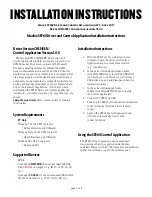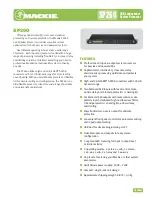
If the LED is ON (bright) then voice and data testing should be completed by
using an ISDN Basic Access Tester, Digital CPE Simulator, laptop or similar
device. Use the tester to confirm “Power Source 1 restricted”. A brightly lit state
will confirm layer 1 activated but not the presence of a TEI. On System X ex-
changes a double slow flash may be observed every 15 seconds, this is caused
by the line card toggling between Info State 2 and 0. This is typical of all embed-
ded System X lines when there is no CPE connected or CPE is detected but not
in the correct Info State. The LED not lit or permanently fast flashing indicates a
problem with the network connection. A permanently slowly flashing LED could
indicate a problem with the customer wiring or CPE. BT Engineers Assistance
Website - http://customerservice.intra.bt.com/eassistant/
6. NTE Bypass function for PSTN and Broadband mode (Extended Use)
The NTE will detect the line voltage from the exchange and switch automatically
to the ISDN or PSTN mode. The NTE will provide PSTN service to the PSTN
socket if a standard analogue line card is used and will act as an NTE5. When
the ISDN service is jumpered/enabled in the Local Exchange, the NTE supports
ISDN services and the PSTN socket is disconnected. The NTE will switch back
to the analogue PSTN mode if the ISDN service is removed/de-configured.
The NTE will switch out of copper bypass at 75 ±8 volts and switch back into
copper by-pass when the voltage falls below 30 ±3 volts. An internal switch
SW3 (position: see fig. 3) is provided so the installer can over ride the by-pass
feature to allow operation on low voltage ISDN lines.
Analogue & ADSL
Equipment
Network cable entry
Figure 4
7. Example S-BUS Connections
Switch IN/OUT to OUT and L/S to S
Last socket (TE1) must include termination resistors
Extended Passive Bus
Last socket (TE1) must include termination resistors
Point-to-Point
Switch IN/OUT to OUT and L/S to L
Socket (TE1) must include termination resistors
Short passive bus
Last socket (TE1) must include termination resistors
TE1
TE2
TE8
S/T
150m max.
< 1m max.
NTE 8
Switch IN/OUT to OUT and L/S to S
TE1
S/T
150 m ... 800 m
NTE 8
TE
1
TE
2
TE
4
S/T
500 m ... 800 m
< 1 m
25 m ... 50 m
NTE 8
TE1
TE2
TE8
S/T
150m max.
NTE 8
Switch IN/OUT to OUT and L/S to L
Daisychained
Figure 5
5
6
Functional Block Diagram
RJ45
RJ45
ISDN- signal
switching unit
By-Pass
Detection
PSTN
Exch
1
µ
8
470k
PSTN / ADSL Broadband By-Pass
Figure 6
Technical Data
U interface
TS 102 080, Annex A
Channel structure
2B+D, synchronization and service data
Line code
2B1Q
Net data rate
144 kbps (2 x 64 kbps + 16 kbps)
Safety status
TNV3 (Telecommunication Network Voltage)
S/T interface
according to ETS 300 012
Channel structure
2B+D, synchronization and monitoring
Bus configuration:
(default setting)
S = Short passive bus
IN = 50
Ω
Terminating Resistors
Safety status
TNV1 (Telecommunication Network Voltage)
Power ITU-T
I.430
Wattage on S/T interface < 420 mW in operation
Dimensions and environmental conditions
Storage
ETS 300 019-1-1, Class 1.1 (-25°C to +55°C)
Transport
ETS 300 019-1-2, Class 2.3 (-25°C to +55°C)
Operation
ETS 300 019-1-3, Class 3.2 (-5°C to +55°C)
Case
123 x 130 x 50 mm
Weight 0.5
kg
Our products are subject to continuous further development and improvement.
Safety
This equipment complies with the European directives
89/336/EEC “Electromagnetic Compatibility” (EMC) and
73/23/EEC “Low Voltage Directive”.
Do not work on the NTE and its wiring, e.g. connect or dis-
connect cables, during periods of lightning activity.
Hazardous Voltages !
Remote Power Feeding / ISDN connection (Line)
The ISDN connection is regarded as a source of voltage that
should be inaccessible to user contact. Do not attempt to
tamper with or open the NT1 or the connection hardware.
Maintenance must be made only by suitably trained engi-
neers.
ESD Protection (for service personnel)
When handling the unit with the cover opened, please use
ESD protection methods acc. to EN 100 015.
Not required for normal installation.
All customer ordered facilities must be tested prior to handover to
customer.
This guide should be retained for future reference.
Returns
If the NTE is proved to be faulty on installation, please return it using the
BT return procedure.
If you have any comments to make about this documentation, or the ISDN NTE
please email: [email protected].
The information contained in this guide is correct at the time of going to press, but it is not
comprehensive and shall not form any part of a contract. Some products and services may
not be available in all areas. Whilst we do our best to supply customers with the products
and services that they ask for, we reserve the right to supply products and services which
do not accord exactly with the descriptions and illustrations in this guide.
7
8
Hinweis für die Herstellung: Papier unterhalb dieser Linie abschneiden!
Note: Cut off paper below this line!
2µ2
470k



















